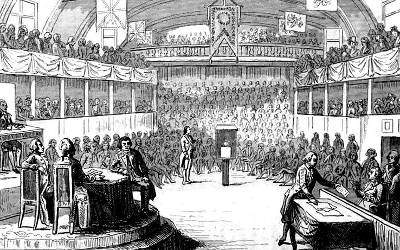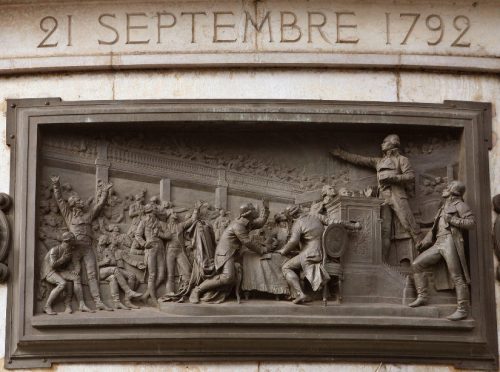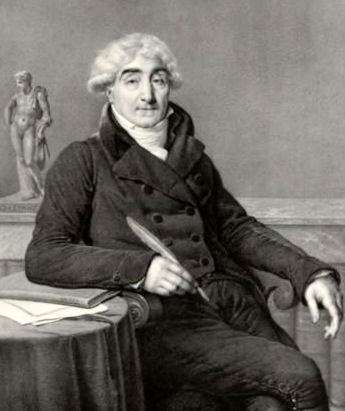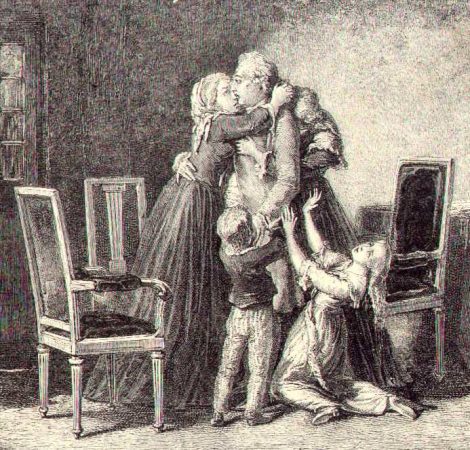
In December 1792, the National Convention put the deposed Louis XVI on trial for 33 charges of betrayal, sabotage or failure of leadership. After weeks of testimony and deliberation, all 693 of the Convention’s deputies found him guilty. Subsequent votes condemned him to execution without the right of appeal. On January 21st 1793, the former king was carted to the guillotine and decapitated. The trial and execution of Louis XVI caused a sensation across France and around the world. Kings had been assassinated, overthrown and toppled by military defeat – but for a reigning monarch to be tried and executed in public by his own people was almost unparalleled.
Background
The fate of the king was probably decided after the August 10th attack on the Tuileries. As Louis and his family took refuge in the chamber of the Legislative Assembly, the crowd outside bayed for their arrest and the abolition of the monarchy. The deputies of the Assembly agreed to both.
The former king was suspended from power, arrested and removed to the Temple, an ancient fortress in the northern quarter of Paris. Stripped of his royal and noble titles, Louis became known as ‘Citizen Louis Capet’, a more humble name derived from his ancestors.
Public pressure demanded the king be put on trial, however there was considerable legal advice against this. The Constitution of 1791, which was still in place when the king was arrested, placed the monarch outside the jurisdiction of the courts. It also protected him from any punishment other than dethroning.
The Convention deliberates

On November 7th, the National Convention’s legislative committee tabled a report asking “Is Louis XVI ‘judgeable’ for the crimes he is imputed to have committed on the constitutional throne?” The Convention spent much of the next month debating the question.
The September Massacres two months earlier cast a long shadow over these proceedings. Many of the Convention’s deputies had been radical democrats in the Legislative Assembly and the Jacobin club – but the wanton slaughter in early September worried these reasonable men. The revolution seemed to be moving too fast and slipping into mob rule. To put the king on trial and possibly under the guillotine may accelerate unrest and push France into anarchy or civil war.
Two of the Convention’s deputies, Charles-François Morisson and Claude Fauchet, argued that the king could only be tried under the Constitution of 1791; there was no other law that applied to him. Jean-Marie Rouzet believed the king was answerable for his crimes but argued that placing him on trial was provocative, potentially disruptive and not in the national interest.
In contrast, Maximilien Robespierre argued that no trial was necessary. The people had already delivered their verdict on the king, Robespierre argued, with their actions on August 10th.
Committed to trial

On December 3rd, the National Convention resolved that Louis would indeed be tried. Controversially, the Convention itself would act as his judge and jury. Because there was no legal or constitutional facility for a legislative body to act as a court, the Convention’s decision was highly irregular and of doubtful legality.
The king’s trial began a week later, on December 11th 1792. In the few days available to him, Louis assembled a defence team containing some of France’s best lawyers: the gifted orator Raymond de Sèze; François Tronchet, who had interrogated Louis after his arrest at Varennes; and Guillaume Malesherbes, the retired jurist and former minister of state.
These men prepared the king’s defence thoroughly and delivered it with vigour, in spite of the dangers to their careers and their lives. De Sèze, who was given limited time to prepare and had barely slept for four days, delivered a brilliant opening address that focused on the king’s inviolability and the Convention’s unfitness to judge him:
“You want to pronounce on the fate of Louis, yet it is you yourselves who accuse him! You want to pronounce on the fate of Louis, yet you have already declared your views! You want to pronounce on the fate of Louis, yet your opinions are already spread across Europe!”
The king’s defence
The former king took a close personal interest in his defence. He spent hours each day with his lawyers: their discussions, later described by Malesherbes and Louis’ valet Jean-Baptiste Cléry, were intelligent and lively.
The king had the final say on legal arguments, as well as oversight and approval of all speeches. He would not allow his counsellors to claim he was ignorant of the law, nor would he permit them to invoke pity with emotive language. Under Louis’ instructions, his lawyers instead focused on his constitutional inviolability as monarch and the illegality of the trial. Raymond de Sèze dissected the charges one by one, skilfully refuting claims that the king was to blame for broken oaths, foreign aggression, émigrés, military failures, bloodshed at the Champ de Mars and the Tuileries.
While the deposed king had masterful advocates and brilliant men at his side, unfortunately for Louis, he was damned by his own testimony. His utterances in the witness chair, like many of his utterances on the throne, ranged from stubborn and indignant to evasive and vacillating. To claim the inviolability provided by the constitution, Louis had to present as a monarch who trusted the constitution. Given the political climate inside and outside the Convention, it would have taken a masterful performance to save the former king, but his responses under cross-examination were far from masterful.
A guilty verdict

On January 15th 1793, following a short deliberation, the Convention’s deputies handed down a unanimous guilty verdict, 693 votes to none. A total of 49 deputies chose to abstain or were absent.
The question turned to the king’s fate. Outside the Convention, the gutter press and the Paris sections screamed for his execution. The Jacobins within the Convention also supported the death penalty. The Girondins, however, feared the ramifications of bowing to the Paris crowd and executing the king without a public mandate. Since Christmas 1792, Girondin deputies had been lobbying for an appel au peuple (‘appeal to the people’) – in effect, a national referendum on whether the king should die. This issue further exposed the gulf between the Paris-centric Jacobins and the nationally-minded Girondins.
The fate of the king was eventually concluded on January 17th. It was the Jacobins who won the day, gaining the support of the Plain and defeating the motion for an appel au peuple by 424 votes to 283. The Convention then voted 387 to 334 in favour of executing the former king. A group of 72 deputies raised a supplementary motion urging clemency and a reprieve for the king, but this motion was voted down 380 to 310.
Execution

The Convention finalised the former king’s death warrant on January 20th and ordered his execution within 24 hours.
On receiving this order, Louis requested a three-day stay of execution, to farewell his wife and children and prepare “to appear in the presence of Almighty God”. Louis was granted a final visit from Marie Antoinette and his children on the evening of January 20th, however, his other requests were refused.
On January 21st, the former Louis XVI, the last absolutist king of France, awoke before dawn and received mass from a non-juring priest. He boarded a carriage and was taken on a circuitous route through Paris, through streets lined with soldiers and sans-culottes. A Royalist plot to rescue the king came to nothing.
At 10am, the carriage arrived at the Place de la Révolution, formerly the Place de Louis XV, a public square between the Champs-Élysées and the Tuileries. The execution was attended by a crowd exceeding 100,000, so numerous reports of the king’s demise exist. This one comes from a royalist named Bernard, who described the events of January 21st in a letter to his mother:
“[The king] wished to speak to the people from the scaffold but was interrupted by a drum roll and was seized by the executioners, who pushed him straight under the fatal blade. He was only able to say these words in a strong voice: ‘I forgive my enemies. I trust that my death will be for the happiness of my people, but I grieve for France and I fear she may suffer the anger of the Lord’. The king took off his coat at the foot of the scaffold. When someone sought to help him, he said cheerfully ‘I do not need any help’… On the scaffold, the executioner tied his hands behind his back and then cut his hair. After his death, his body and head were taken to the parish cemetery and thrown into a pit 15 feet deep, where they were consumed with quicklime.”
Response
The news of Louis’ execution shocked Europe. In Britain, there was a scathing response to the king’s guillotining. The London press, which by 1792 had written off the revolution as a descent into anarchy, painted the king’s execution as a needless act of regicide. While the bloodthirsty sans-culottes rejoiced, wrote The Times, “honest citizens… could not suppress their heartfelt grief and mourned in private”.
Four days after Louis’ death, Britain expelled the French ambassador. The National Convention responded by declaring war on England on February 1st. The Russian empress Catherine the Great also broke off diplomatic relations with France, while the rulers of Austria and Prussia ordered a significant escalation in military action against revolutionary France.
In the United States, a nation which had won its independence with the support of the now-dead king, the reaction was more restrained. Americans mourned the death of Louis the man but they did not mourn the death of his monarchy. Some radical American journalists went as far as suggesting that the former king had betrayed his people and had got what he deserved.
“The king had decided on his defence at the time of his interrogation, and it was his decision and his alone. He would defend himself not as an anointed king but as a constitutional monarch who had fulfilled his oath of office. He was determined to fight for his life by providing his innocence in an adversary proceeding. He had no illusions about the outcome of the trial, as he told Malesherbes at their first interview: ‘I am sure they will make me perish. They have the power and the will to do so. That does not matter. Let us concern ourselves with my trial as if I could win, and I will win, since the memory that I will leave will be without stain’.”
David P. Jordan, historian

1. In late 1792 the National Convention placed the deposed king, Louis XVI, on trial for crimes against the French people. In a controversial legal move, the Convention’s deputies decided to conduct this trial themselves.
2. Under the Constitution of 1791, the king was considered inviolable and therefore could not be prosecuted or punished. Louis’ lawyers used this as their main defence, arguing that the king’s decisions were valid under the constitution.
3. While his lawyers argued skilfully, Louis’ own testimony was unconvincing. The Convention’s deputies eventually voted 693 to none in favour of the king’s guilt.
4. The Convention then debated the fate of the king, with the Jacobins demanding his execution and the Girondins supporting an ‘appeal to the people’. The deputies voted 387 to 334 for the king’s execution.
5. Following a meeting with his family, the former Louis XVI was guillotined before a crowd exceeding 100,000 people. His execution caused shock waves and condemnation around the world, most notably in Britain, which within a fortnight was at war with France.
Citation information
Title: ‘The trial and execution of Louis XVI’
Authors: Jennifer Llewellyn, Steve Thompson
Publisher: Alpha History
URL: https://alphahistory.com/frenchrevolution/trial-execution-of-louis-xvi/
Date published: September 29, 2019
Date updated: November 6, 2023
Date accessed: July 27, 2024
Copyright: The content on this page is © Alpha History. It may not be republished without our express permission. For more information on usage, please refer to our Terms of Use.
